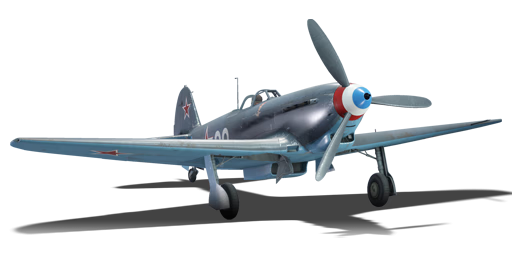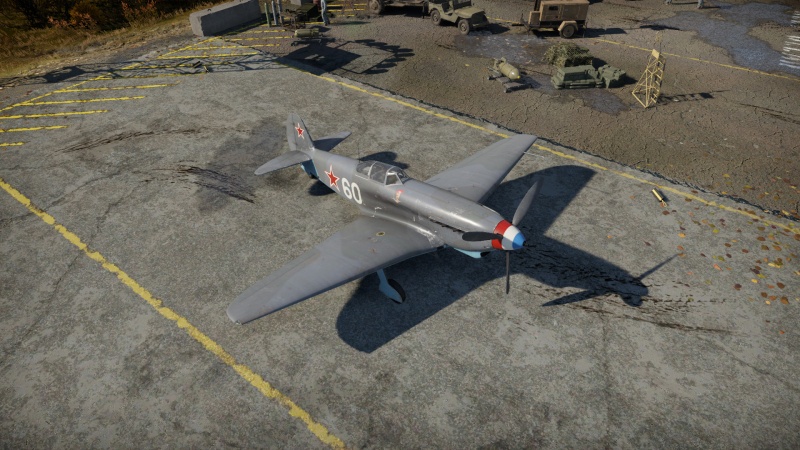Challe's Yak-9T (France)
| This page is about the French fighter Challe's Yak-9T (France). For other versions, see Yak-9 (Family). |
Contents
Description
This Yak-9T White 60 was flown by French pilot René M. P. A. Challe, who served in the Normandie-Niemen squadron, a French fighter squadron that fought on the Eastern Front of World War II under Soviet command. During the Battle of France, Challe was part of the GC III/7 and was shot down in his M.S.406, which led to his hospitalization. After recovering, he escaped occupied France in 1943 with eight fellow aviators through Spain and volunteered to join the Normandie-Niemen regiment in Tula, USSR. He was assigned to his Yak-9T White 60, where he painted the emblem of his previous squadron and acquired eight confirmed aerial victories. On his last flight on January 17, 1945, he was gravely injured when Minengeschoß rounds exploded in his cockpit, severely injuring his left hand and arm. Despite his injuries, he survived the engagement, the war, and recovered from his wounds. He passed away on April 4, 2006.
It was introduced in Update 1.73 "Vive la France" and made available briefly for purchase in-game with Golden Eagles ![]() during the 2017 "75th anniversary of the Normandie-Niemen" event commemorating the Franco-Soviet squadron. The 37 mm NS-37 cannon of the Yak-9T was a fearsome weapon. However, due to its reload time and ammunition capacity, “spray and pray” firing tactics were not an option. As Challe demonstrated time and again, the best bet was to manoeuvre his fighter as close to the enemy as possible, sometimes within 100 metres, and then engage with the cannon. At this range, the cannon had a better chance of hitting its target, and as demonstrated by Challe, it could remove a wing or disable a pilot with ease. Challe would wait for the target aircraft to manoeuvre in a fashion that would expose enough surface area to reduce the chance of the 37 mm rounds bouncing or deflecting off of the target aircraft. Aside from following Challe’s tactics, the cannon can also be used for its intended role of tank busting, loading AP shells, and diving in on the roofs of tanks bursting through with the relatively high penetration of the cannon, making short work of tanks and excelling as a close air support aircraft.
during the 2017 "75th anniversary of the Normandie-Niemen" event commemorating the Franco-Soviet squadron. The 37 mm NS-37 cannon of the Yak-9T was a fearsome weapon. However, due to its reload time and ammunition capacity, “spray and pray” firing tactics were not an option. As Challe demonstrated time and again, the best bet was to manoeuvre his fighter as close to the enemy as possible, sometimes within 100 metres, and then engage with the cannon. At this range, the cannon had a better chance of hitting its target, and as demonstrated by Challe, it could remove a wing or disable a pilot with ease. Challe would wait for the target aircraft to manoeuvre in a fashion that would expose enough surface area to reduce the chance of the 37 mm rounds bouncing or deflecting off of the target aircraft. Aside from following Challe’s tactics, the cannon can also be used for its intended role of tank busting, loading AP shells, and diving in on the roofs of tanks bursting through with the relatively high penetration of the cannon, making short work of tanks and excelling as a close air support aircraft.
General info
Flight performance
The Yak-9T has a very similar flight performance to other Yaks. It has very good low-speed handling and good turn as well as energy retention. The engine is not as powerful as that of the Bf-109 or the P-51, but it still features a good acceleration for its BR, and while the rate of climb is not the best, it keeps up with other fighters, it should be noted that the Yak-9s engine performs better at altitudes below 4000-3000 m.
| Characteristics | Max Speed (km/h at 4,000 m) |
Max altitude (metres) |
Turn time (seconds) |
Rate of climb (metres/second) |
Take-off run (metres) | |||
|---|---|---|---|---|---|---|---|---|
| AB | RB | AB | RB | AB | RB | |||
| Stock | 576 | 560 | 10000 | 18.8 | 19.5 | 13.7 | 13.6 | 366 |
| Upgraded | 610 | 593 | 17.2 | 18.0 | 18.5 | 16.0 | ||
Details

| Features | ||||
|---|---|---|---|---|
| Combat flaps | Take-off flaps | Landing flaps | Air brakes | Arrestor gear |
| X | X | ✓ | X | X |
| Limits | ||||||
|---|---|---|---|---|---|---|
| Wings (km/h) | Gear (km/h) | Flaps (km/h) | Max Static G | |||
| Combat | Take-off | Landing | + | - | ||
| 683 | 320 | N/A | N/A | 280 | ~12 | ~9 |
| Optimal velocities (km/h) | |||
|---|---|---|---|
| Ailerons | Rudder | Elevators | Radiator |
| < 380 | < 420 | < 490 | > 340 |
Survivability and armour
- 64 mm Bulletproof glass in cockpit front and rear.
- 8 mm Steel plate in the pilot's seat.
Modifications and economy
Armaments
Offensive armament
Challe's Yak-9T (France) is armed with:
- 1 x 37 mm NS-37 cannon, nose-mounted (30 rpg)
- 1 x 12.7 mm Berezin UB machine gun, nose-mounted (200 rpg)
Usage in battles
The Yakovlev 9-T or Yak-9T, is the most popular of the Yak-9 series and is best played differently depending on the situation the pilot finds themselves in.
To begin, make sure that you take off and immediately climb. A twenty-degree angle may be too much to handle depending on the number of upgrades purchased on the aircraft, so initially, a 15° climb will suffice. With it, the pilot keeps much-needed speed and agility. Altitude advantage over your opponent is always preferred, and most pilots of the tier that the Yak-9T fights, do not choose to climb over 2,000 metres (6,561 feet) A good altitude to climb to is 3,000 metres (9,842 feet) to gain the altitude advantage over the enemy. Be advised this will not always be the case and some enemies will climb above you, if this happens, try to make them bleed energy until they are slower than you and turn-fight them.
At high altitudes, the Yak 9T is best suited to energy fighting, which means using the Yak's good energy retention to zoom at an opponent, shoot at them, and then climb up and turn back to your opponent and give chase. The Yak at mid to low altitude is best suited to turn-fighting against all nations except for the Japanese. If facing the Japanese, use the same energy fight tactics as stated above, as Japanese planes will be unable to give chase due to the low energy retention of their lightweight aircraft. The Yak-9T comes equipped with flaps, it is critical you use them, as performance is significantly increased in a turn-fight with them opened.
The Yak-9T and typically speaking, all Yak aircraft suffer from constant engine overheat which requires properly watching the temperature to ensure it does not stay critical for too long or the engine will die and the plane becomes subject to the laws of gravity. Keep eyes on the temperature at all times. The best advice is to keep the throttle at 90% or lower when not in combat. The Yak-9T is best suited for flying in colder maps, however, if on a hot map, gain altitude and cruise at 85-90% throttle.
Manual Engine Control
| MEC elements | ||||||
|---|---|---|---|---|---|---|
| Mixer | Pitch | Radiator | Supercharger | Turbocharger | ||
| Oil | Water | Type | ||||
| Controllable | Controllable Not auto controlled |
Controllable Not auto controlled |
Controllable Not auto controlled |
Separate | Controllable 2 gears |
Not controllable |
Pros and cons
Pros:
- Cannon is quite accurate and powerful
- Has 30 shells for the 37 mm and a reasonably high rate of fire compared to its calibre
- Decent manoeuvrability
- Cannon can knock out medium tanks with several hits in the side or rear
Cons:
- The 37 mm chews through ammunition quickly; afterwards, you only have a single 50. Cal machine gun (unless you wait for reload in arcade or return to base in realistic or simulator battles)
- 37 mm has high recoil
- Lousy high-altitude performance
History
Describe the history of the creation and combat usage of the aircraft in more detail than in the introduction. If the historical reference turns out to be too long, take it to a separate article, taking a link to the article about the vehicle and adding a block "/History" (example: https://wiki.warthunder.com/(Vehicle-name)/History) and add a link to it here using the main template. Be sure to reference text and sources by using <ref></ref>, as well as adding them at the end of the article with <references />. This section may also include the vehicle's dev blog entry (if applicable) and the in-game encyclopedia description (under === In-game description ===, also if applicable).
Notable pilots

Media
- Skins
See also
Links to the articles on the War Thunder Wiki that you think will be useful for the reader, for example:
- reference to the series of the aircraft;
- links to approximate analogues of other nations and research trees.
External links
| A.S. Yakovlev Design Bureau (Яковлев Опытное конструкторское бюро) | |
|---|---|
| Fighters | |
| Yak-1 | Yak-1 · Yak-1B |
| Yak-3 | Yak-3 · Eremin's Yak-3(e) · Yak-3 (VK-107) · Yak-3P · Yak-3T · Yak-3U |
| Yak-7 | Yak-7B |
| Yak-9 | Yak-9 · Yak-9B · Yak-9K · Golovachev's Yak-9M · Yak-9P · Yak-9T · Yak-9U · Yak-9UT |
| Twin-engine fighters | I-29 |
| Jet fighters | |
| Yak-15 | Yak-15P · Yak-15 |
| Yak-17 | Yak-17 |
| Yak-23 | Yak-23 |
| Yak-30 | Yak-30D |
| Yak-141 | Yak-141 |
| Strike aircraft | |
| Yak-2 | Yak-2 KABB |
| Yak-38 | Yak-38 · Yak-38M |
| Bombers | Yak-4 |
| Jet bombers | Yak-28B |
| Foreign use | ▄Yak-3 · Challe's ▄Yak-9T · ◔Yak-9P |
| Captured | ▀Yak-1B |
| France fighters | |
|---|---|
| Dewoitine | D.371 · D.371 H.S.9 · D.373 · D.500 · D.501 · Pallier's D.510 · D.520 |
| Morane-Saulnier | M.S.405C1 · M.S.406C1 · M.S.410 |
| Arsenal | V.G.33C-1 |
| Bloch | M.B.152C1 · M.B.157 |
| Caudron | C.R.714 |
| Sud-Ouest | S.O.8000 Narval |
| Belgium | ▄Gladiator Mk I · ▄Spitfire FR Mk XIVe |
| American | H-75A-1 · H-75A-4 · ▄P-39Q-25 · ▄P-40F-5 Lafayette · ▄P-47D-22-RE · ▄P-63C-5 · F-6C-10-NA |
| ▄F6F-5 · ▄F6F-5N · F4U-7 · ▄F8F-1B | |
| Other countries | ▄Seafire LF Mk.III · ▄Yak-3 · Challe's ▄Yak-9T · NC.900 |
| France premium aircraft | |
|---|---|
| Fighters | D.371 H.S.9 · Pallier's D.510 · ▄P-39Q-25 · ▄P-40F-5 Lafayette · ▄P-47D-22-RE · F-6C-10-NA |
| M.B.152C1 · ▄Yak-3 · Challe's ▄Yak-9T · NC.900 · S.O.8000 Narval | |
| Jet fighters | Milan · Mirage F1C-200 |
| Strike aircraft | ▄AD-4NA · F-84F IAF |
| Bombers | Late 298D · ▄PBY-5A Late |
| Jet bombers | Vautour IIA IDF/AF · S.O.4050 Vautour IIN |





